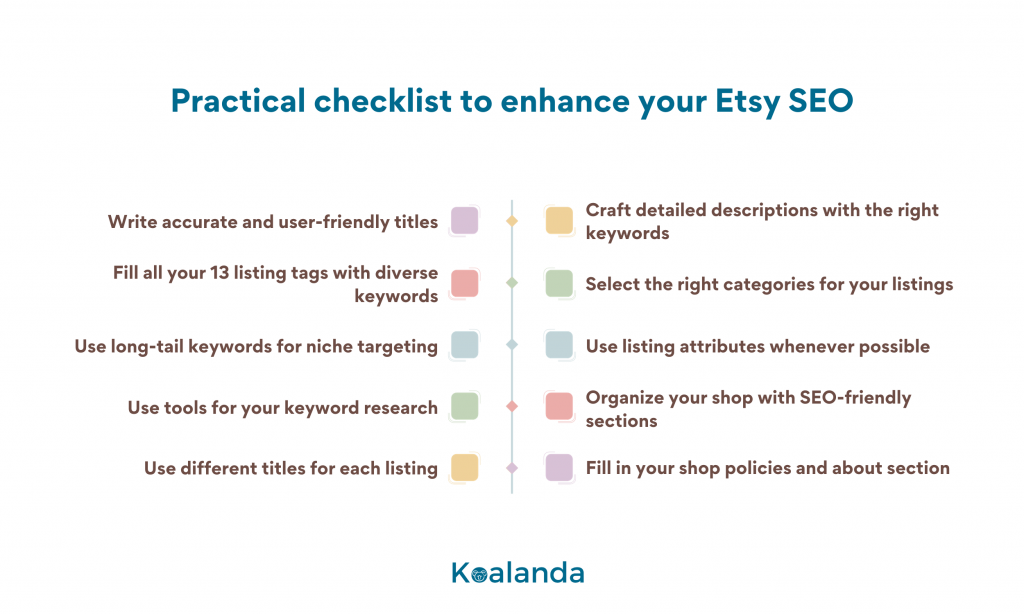For newcomers to the Etsy marketplace, the term SEO can often sound like a complex puzzle that’s tough to solve. It’s one of the aspects of setting up shop that can seem daunting, overshadowing even the excitement of selling your unique creations. Yes, SEO does have its technicalities and nuances – it’s a craft in itself that doesn’t necessarily mirror the artistry of your handmade items. It requires a willingness to learn, experiment, and fine-tune your approach over time.
However, there’s good news for those who might feel overwhelmed: achieving a solid foundation in Etsy SEO is more straightforward than it may appear. While perfection in SEO is a journey of continuous improvement, getting to a place where SEO isn’t a barrier to sales is achievable with some basic, clear-cut actions. This article provides a straightforward practical checklist to enhance your Etsy SEO, helping your shop attract and engage with interested customers.

Table of Contents
Write accurate and user-friendly titles
The title of your listing serves as a first impression and a crucial handshake between your product and a potential buyer. It’s where clarity meets curiosity. Imagine a buyer searching for a handmade ceramic mug. A title like “Handcrafted Ceramic Coffee Mug – Blue Pottery Cup with Cozy Grip” immediately informs and attracts.
Etsy has shifted its emphasis towards user-friendly titles over the years. This means that while keywords are important, they shouldn’t overwhelm the customer. Instead of a title crammed with terms like “Ceramic Mug, Handmade Mug, Artisan Coffee Cup,” which can be off-putting and confusing, opt for simplicity and relevance. Write descriptive titles that naturally incorporate essential keywords without feeling forced.
Action: Take a look at your titles. Are they informative and enticing to a customer while still containing your main keywords? If not, it’s time to refine them.
Fill all your 13 listing tags with diverse keywords
Etsy provides you with 13 opportunities – tags – to capture the myriad of ways shoppers might think about a product like yours. If you sell knitted scarves, for example, beyond the obvious “knitted scarf,” consider the material (“alpaca wool scarf”), the pattern (“chevron knit scarf”), the recipient (“unisex scarf”), and even the season (“winter scarf”).
Using all 13 tags is your chance to cover a broad spectrum of relevant search queries. For instance, if your product is a hand-painted vase, your tags could range from “floral vase” to “acrylic painted decor,” capturing both the essence of the product and the potential uses or interests of the buyer.
Action: Review each of your listings to ensure you’re using all 13 tags. Avoid redundancy; if you have a tag “hand-painted vase,” you don’t need another tag saying “painted vase.” You can use Koalanda’s listing issues tool to identify these problems in your shop.
Use long-tail keywords for niche targeting
The concept of long-tail keywords often seems wrapped in mystery, but it’s actually quite straightforward. These are simply more specific phrases that shoppers might enter into Etsy’s search when they have a clear idea of what they want. For instance, instead of the broad term “scarf,” a long-tail keyword would be “handmade wool infinity scarf.”
Why are these valuable? Because they often lead to higher conversion rates. A shopper searching for “handmade wool infinity scarf” has a very specific product in mind and is likely further along in the buying process than someone who searches for “scarf.”
Action: Review your listings and identify generic tags. Can you extend them into more descriptive phrases? If you have “earrings” as a tag, consider specifying the type, material, and style, such as “boho drop earrings.”
Use tools for your keyword research
Selecting a wide array of relevant keywords is often a hurdle for new Etsy sellers, and it’s even more complex when it comes to pinpointing long-tail keywords.
Relying on search engines like Google for keyword discovery may lead you down a vague path, filled with guesswork about what terms might draw shoppers to your products. A more reliable approach is to utilize specialized Etsy keyword research tools tailored specifically for the marketplace.
Tools such as Koalanda are designed to streamline this process. They not only suggest a wealth of pertinent keywords but also provide valuable data on search volume and competition levels. This information is crucial in determining the viability of a keyword for your shop. Without these insights, you’re navigating by intuition, which can be hit or miss.
Action: Commit to using a keyword research tool. Koalanda is a solid choice, offering accurate data on search volume and competition, an expansive selection of keywords, daily unlimited searches, and features to organize your favorite keywords.
Use different titles for each listing
While tags are the primary space for a variety of keywords, the titles of your listings shouldn’t be neglected. If you have several listings that are similar, it’s important to differentiate each one with a unique title. This isn’t just to avoid repetition; it’s a strategic move to cover a broader range of search queries and to test what resonates best with buyers and the Etsy search algorithm.
For example, if you’re selling hand-knit scarves and have several listings that are similar in style but vary in color or pattern, you can modify each title to highlight different attributes. One title might be “Handmade Chunky Knit Scarf – Winter White Wool,” while another could be “Cozy Hand-Knit Scarf – Soft Ivory Cable Pattern.”
This subtle variation allows you to capture different search intentions and preferences, potentially attracting a wider audience. It also provides valuable data over time, as you’ll be able to see which titles perform better, giving you insights into buyer behavior and search trends.
Action: Conduct a review of your listings. Identify any that have duplicate titles and inject variety by using synonyms, rearranging the words, or emphasizing different product features.
Craft detailed descriptions with the right keywords
Product descriptions on Etsy serve a dual purpose: they communicate the essence of your product to the customer and signal to Etsy’s algorithm what you’re selling. Unlike titles, descriptions give you the space to weave a narrative that includes a wide range of relevant keywords without appearing forced or unnatural.
A well-crafted description does more than list the product features; it tells a story. For instance, instead of simply stating the materials and size of a handcrafted journal, you can describe the inspiration behind its design, the craftsmanship that went into its creation, and the feel of the paper, all while naturally integrating keywords throughout.
Action: Review your product descriptions to ensure they are rich with keywords that align with your titles and tags. Look for opportunities to add more keywords seamlessly into your descriptions. If you need assistance, consider using AI tools like ChatGPT to help you enhance your product narratives while staying on point with your SEO strategy.
Select the right categories for your listings
Categories in Etsy play a significant role in how potential buyers find your products. They function almost like additional tags, guiding users who are browsing through specific categories to find items that match what they’re looking for. When a shopper selects a category, Etsy filters the listings to show only those within it, making your choice of category as crucial as your keywords.
Moreover, categories are a key component in Etsy’s internal promotions and campaigns. When Etsy highlights items for events or sales, it often pulls from specific categories. If your item is miscategorized, you might miss out on these valuable opportunities for additional exposure.
Action: Take a moment to review the categories of your current listings. Make sure each product is placed in the most accurate category that not only defines the item but also aligns with where your target customers are likely to browse.
Use listing attributes whenever possible
Attributes on Etsy are a powerful tool in the SEO arsenal. They serve as additional tags, helping to match your products with what users are searching for. These attributes are especially important because they enable your listings to align with the filters Etsy users apply when they’re looking for specific items.
When a customer uses filters – like color, material, or style – Etsy narrows down the search results based on the attributes you’ve set for your listings. If your attributes are incomplete or inaccurate, your product might not appear in filtered searches, even if it’s exactly what the customer wants.
For instance, if you’re selling a vintage dress and you’ve only set the attribute for the era but not for the material or color, you could miss out on customers who filter their search for “silk” or “red” dresses. It’s in these details that opportunities are either captured or missed.
Action: Audit the attributes for each of your listings. Check for any that might be incomplete or missing, and update them to reflect the specifics of your products.
Organize your shop with SEO-friendly sections
The way you organize your Etsy shop into sections can do more than just help customers navigate your items; it also influences how your listings rank in search results.
Etsy considers the names of your shop sections as part of its search algorithm. Including keywords in your section titles can give your items an SEO boost, just like tags and titles do. For example, instead of a generic section like “Accessories,” use “Handmade Silk Scarves” if that’s what you’re selling. This specificity can help your products rank higher when customers search for silk scarves.
Action: Re-evaluate the sections in your Etsy shop. Are they named with just the product type, or do they include descriptive keywords as well? Update your section titles to reflect your products more accurately and incorporate relevant keywords where possible.
Fill in your shop policies and about section
A fully fleshed-out Etsy shop profile isn’t just a matter of professionalism – it directly influences your search ranking. Complete shop information, including detailed policies and a rich ‘About’ section, contributes positively to where you appear in search results.
Clear, comprehensive policies, particularly regarding returns and refunds, build customer confidence. Shoppers are more likely to purchase from a shop that has transparent policies, which can lead to higher conversion rates – a factor that Etsy’s algorithm favors.
The ‘About’ section is your chance to tell your story and connect with customers. People come to Etsy for the personal touch they get from buying from real people and craftspeople. Sharing your journey, the story behind your shop, and what inspires you to create your products can resonate with buyers and set you apart.
Action: Examine your shop policies and ‘About’ section. Ensure your policies are up-to-date and reflect your business practices accurately. In your ‘About’ section, tell your story in a way that invites customers to understand and appreciate the passion behind your work.
Conclusion
In this guide, we’ve covered straightforward strategies to establish a good SEO foundation for your Etsy shop. These direct actions are designed to influence the key factors in Etsy’s search algorithm effectively. Yet, the journey doesn’t end here. SEO is multifaceted, with indirect elements like conversion rates, reviews, sales volumes, and branding also playing a crucial role. As you become more adept with these initial steps, you’ll be ready to dive deeper into the nuances of Etsy SEO and further enhance your shop’s success.
If you want to grasp Etsy SEO in greater depth make sure to read our dedicated article on Etsy SEO Myths.





